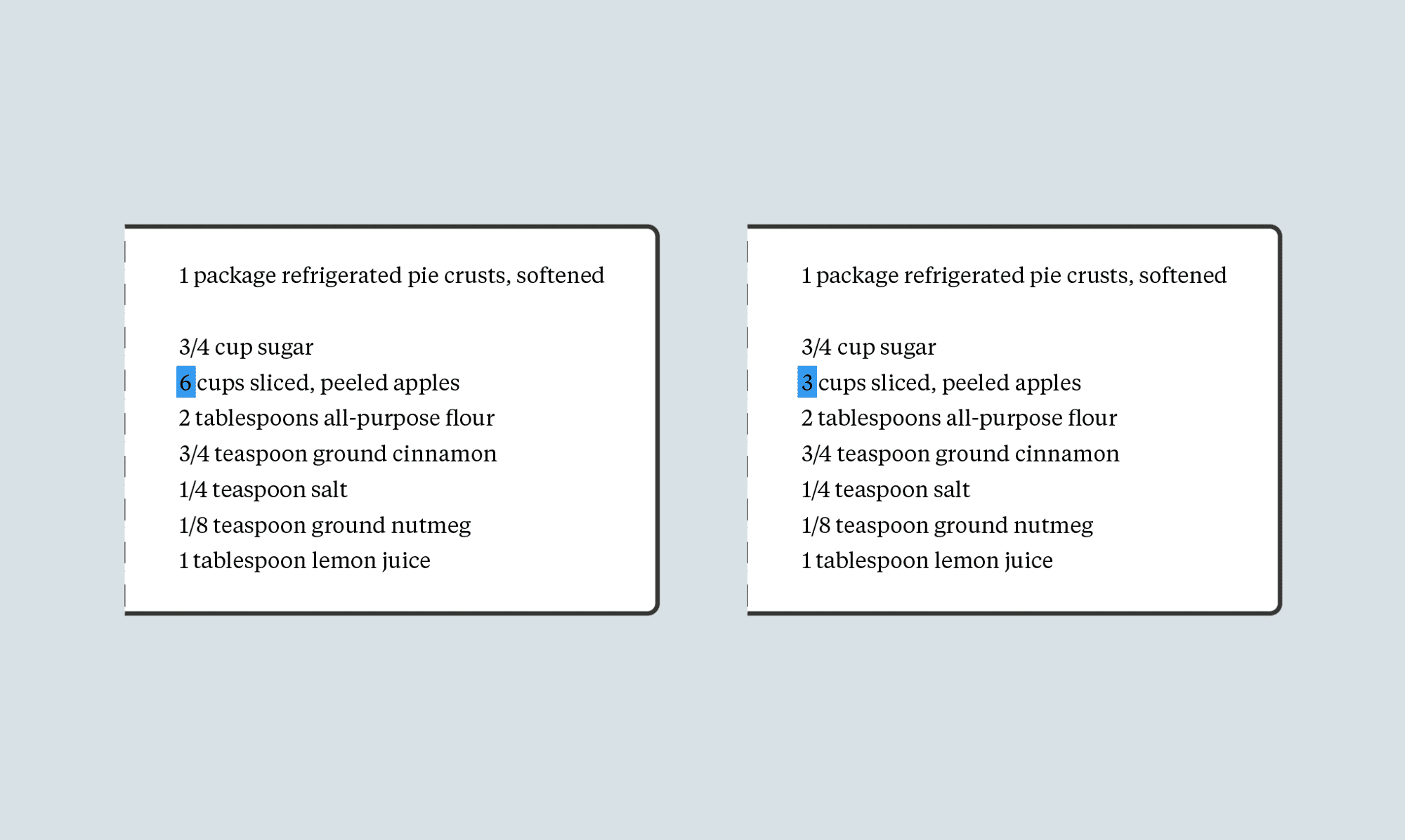The ABCs of DNA: a glossary of genetic terms
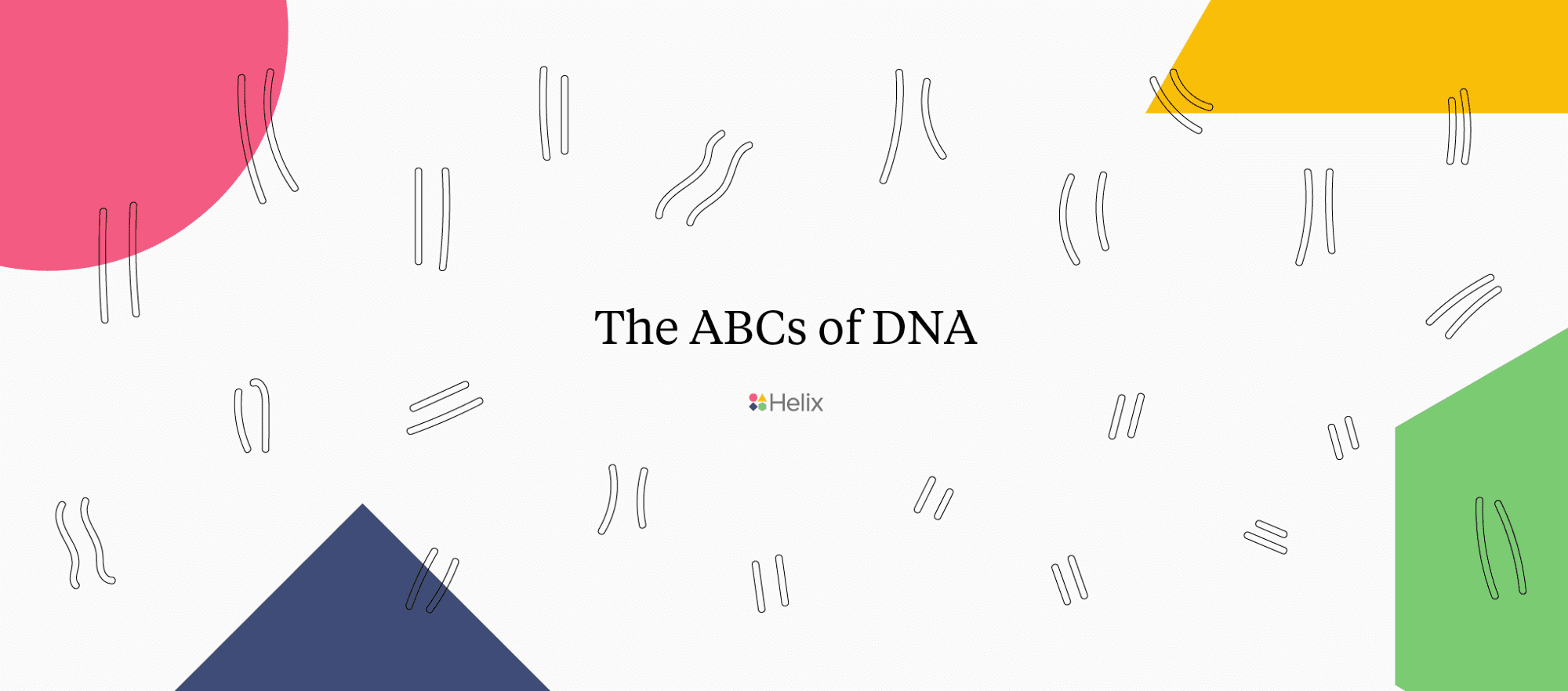
Unless you do a lot of work with pipettes, much of the vocabulary that relates to the story behind your DNA is going to feel foreign. But have no fear, we’re here to help! Soon you’ll be speaking of exons and introns with authority, have good command of Mendelian traits, and know why pharmacogenomics mean you might want to have a chat with your doctor the next time you get a prescription. You could also discover why you’re the kind of bold adventurer who likes to have her DNA sequenced in the first place: it could be genetic.
A (Adenine): One of the four DNA bases. Bases are the most basic unit of DNA. They are Adenine, Cytosine, Guanine, and Thymine. Without them we’re nothing. Like literally nothing.
Amino Acid: The basic unit of a protein, and sometimes called the “building blocks of life”. That’s because amino acids combine to make complete proteins, and proteins combine to make up all of your traits.
Ancestry: An individual’s family or ethnic descent. For example, you can learn if your ancestors are African, Asian, or European. Ancestry can get even more specific, letting you know if your European ancestors were Irish, Scottish, Scandinavian, or a combination. Ancestry analyzes your distant ancestors, those from hundreds of years ago.
Base: The most basic unit of DNA. There are four different bases (Adenine, Cytosine, Thymine, and Guanine), and they make up all DNA. The same four bases are in your DNA, an elephant’s DNA, even the DNA in corn. The bases are what we read when we sequence your DNA, and the order of these letters conveys information that offers us insight into what makes you, you.
Base Pair: Also sometimes called the ‘rungs’ of the DNA ladder. The Adenine base is always across from Thymine (A base pairs with T) and the Cytosine base is always across from Guanine (C base pairs with G). This pairing system is universal — it is never broken. Therefore, if you know the base on one side of DNA, you always know the base on the other side.
Carrier: Being a carrier means you can pass a trait to your children, even when the trait is not visible in you. Someone who has inherited one variant (a single difference in the DNA between two people) for a specific trait. Let’s use the example of eye color. If we say someone is a carrier for blue eyes, it means they have one copy of the blue eyes variant and one copy of the brown eyes variant. Because the brown eyes variant overrides other variants, or what we call dominant, this person will have brown eyes. If this person decides to have children, they could pass either the blue or the brown eyes variant because they have one of each. If both parents pass down a blue eyes variant, the child will have blue eyes. If one parent passes a blue eyes variant and the other passes down a brown eyes variant, the child will have brown eyes.
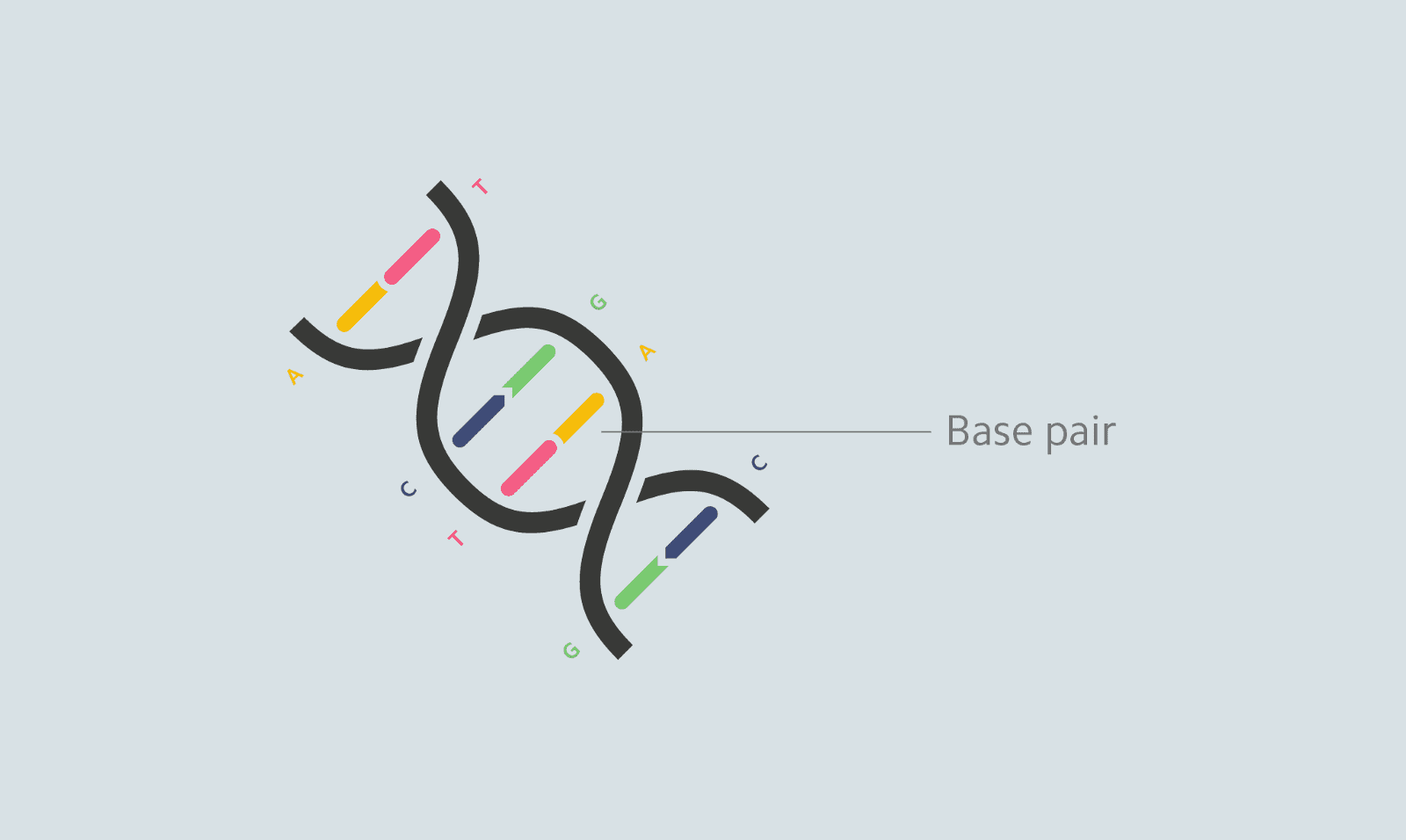
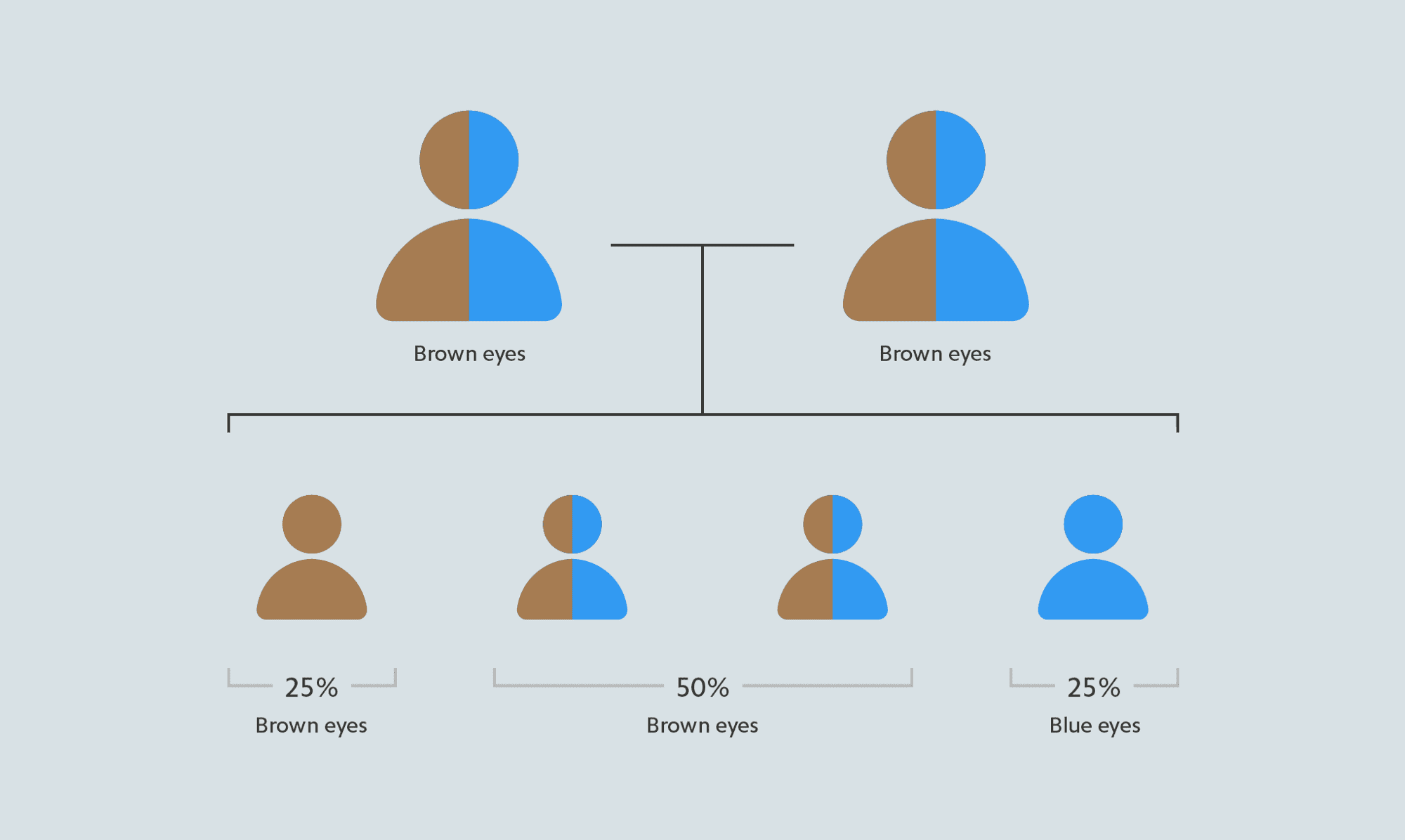
In this example, two brown-eyed carriers may or may not pass on their variants for blue eyes to their children.
Carrier Screening: A type of DNA testing that focuses on family planning and pregnancy. It gives parents information about whether they “carry” any inherited conditions that, while it doesn’t affect the parent’s health, could impact a child. Here’s how it works. We all have two copies of each gene, because we inherited one from our mom and one from our dad. In this same way, like the flip of a coin we pass on one of the two copies to each of our children. There are many inherited conditions, most of them rare (and with complicated, scary sounding names), that are caused by certain genes. But these are known as recessive conditions, meaning that a person needs to have two copies of the gene that doesn’t work in order to have the condition. Having just one version doesn’t impact your health, which is why we say you just “carry” that gene, but it can be important in planning to have children. If both parents are carriers, then there is a chance that a child could inherit both copies of the gene that doesn’t work. Knowing can help parents decide about what types of pregnancy testing, if any, they may want to pursue.
Chromosome: A single continuous strand of DNA that can be anywhere from 50 million bases (chromosome 21) to 250 million bases (chromosome 1). Every person has 23 pairs (or 46 total) chromosomes — one of each pair from your mom and one from your dad. These 23 chromosomes are labeled 1 through 22, and one pair of chromosomes is called the sex chromosomes, because women have two X chromosomes (XX) and men have one X and one Y (XY).
Complex Trait: A trait that is the result of both genetics and the environment. Obesity is a good example of a complex trait. Obesity is influenced by genetics, but it is also influenced by how much you exercise and the amount of junk food you eat. We don’t always understand how genetic and environmental factors interact, which is why these traits are particularly complex.
C (Cytosine): One of the four DNA bases. Bases are the most basic unit of DNA. They are Adenine, Cytosine, Guanine, and Thymine. Without them we’re nothing. Like literally nothing.
Diploid: Diploid refers to having two copies of each chromosome. Humans have two copies of 23 different chromosomes which gives us a total of 46. Most cells in your body are considered diploid because they have two sets of the 23 chromosomes.
DNA: DNA stands for deoxyribonucleic acid. It is the genetic information that every parent passes on to their biological children. DNA plays a role in physical features (height and eye color), in disease (multiple sclerosis, cancer, Alzheimer’s Disease), and even behavioral traits (risk-taking). DNA is made up of four letters (A, C, T, and G) also known as bases (see Base). You can think of DNA as the instructions that we are born with, that are in almost every cell in our body that tells our bodies how to grow and function.
Dominant: A type of variant (a single difference in the DNA between two people). And variants affect traits. You only need one dominant variant to see the effect on a trait because it essentially overpowers the others. For example, brown eyes variants are dominant to blue eyes variants. If you get one copy of the brown eyes variant from your mom OR your dad, you will have brown eyes.
Double Helix: DNA is made up of two strands that are twisted together. You can think of it like a twisted ladder where the base pairs make up the rungs of the ladder. This twisted structure is what we call the double helix.
Exome+: The part of your genome that Helix collects for each customer. The genome can be simplified into two components: parts that code for protein and parts that don’t. The part that codes for protein (~2% of the total genome), also known as the exome, is where we find the majority of known variants that cause disease or affect traits. But, we know that there are important regions that are in the other 98%. Therefore, the + represents all the regions outside the exome that Helix thinks are important, and so we collect those regions too.
Exon: Just like the genome is broken into parts that code for protein (exome) and the parts that don’t, genes are broken into parts that code for protein and parts that don’t. Exon refers to the part of a gene that codes for protein. The exome gets its name from exon. The exome is the collection of all exons.
G (Guanine): One of the four DNA bases. Bases are the most basic unit of DNA. They are Adenine, Cytosine, Guanine, and Thymine. Without them we’re nothing. Like literally nothing.
Gene: A gene is a piece of DNA that is a set of instructions, kind of like a recipe, to build proteins in your body. These proteins are what give you your unique traits. You may have heard of a “sprinter gene” or an “Alzheimer’s gene.” These are genes that help make proteins that play a role in muscles or in the brain.
Genetic Counselor: A healthcare professional who has specialized training to help people understand genetic information, make decisions about genetic testing, and understand what genetic results mean for people and their families. Genetic counselors can help people across many specialities like family planning, oncology, cardiology, neurology, and many more. They work in a variety of settings from hospitals and clinics to laboratories and companies. Some people are referred to a genetic counselor by their doctor, but sometimes people seek out genetic counseling on their own.
Genome: All the DNA in a cell. The genome comes in the form of 23 pairs of chromosomes (plus some mitochondrial DNA).
Genomics: The field of science that studies how the entire genome affects human traits.
Genotyping: A technology that looks at single bases (Adenine, Cytosine, Thymine, and Guanine) in the genome. You can look at as few as one base or as many as 1 million bases and it is still called genotyping. One important thing to know about genotyping is that the bases you look at are scattered throughout the genome. If we use the analogy of your genome being a book, genotyping would be like choosing a single letter at random on every page in the book. The biggest limitation to genotyping is that after you choose the letters, you can’t go back and choose a different one. This might become important if there is a new scientific discovery in the future about a letter on a page you didn’t choose to have genotyped. In that case, you would need to be tested again.
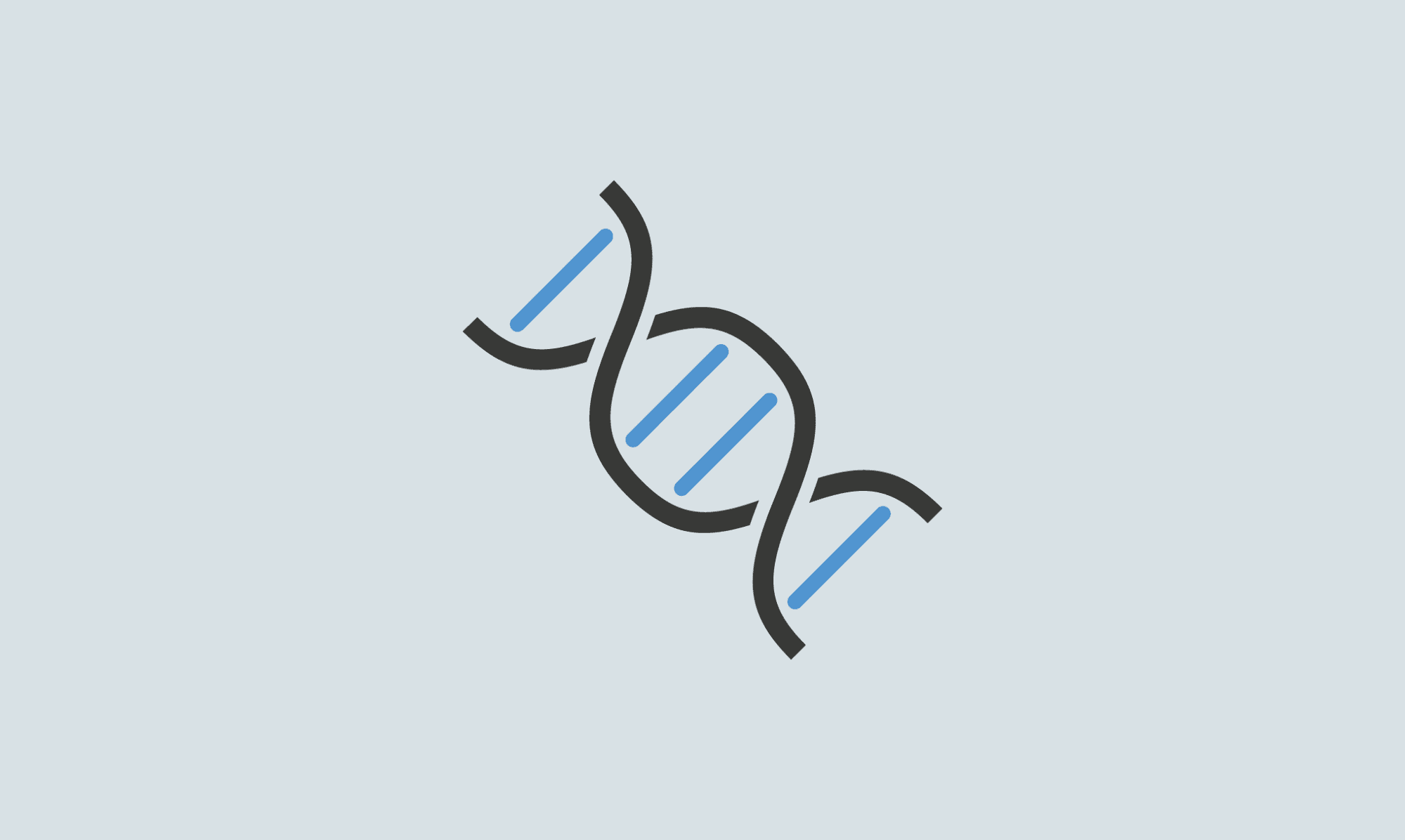
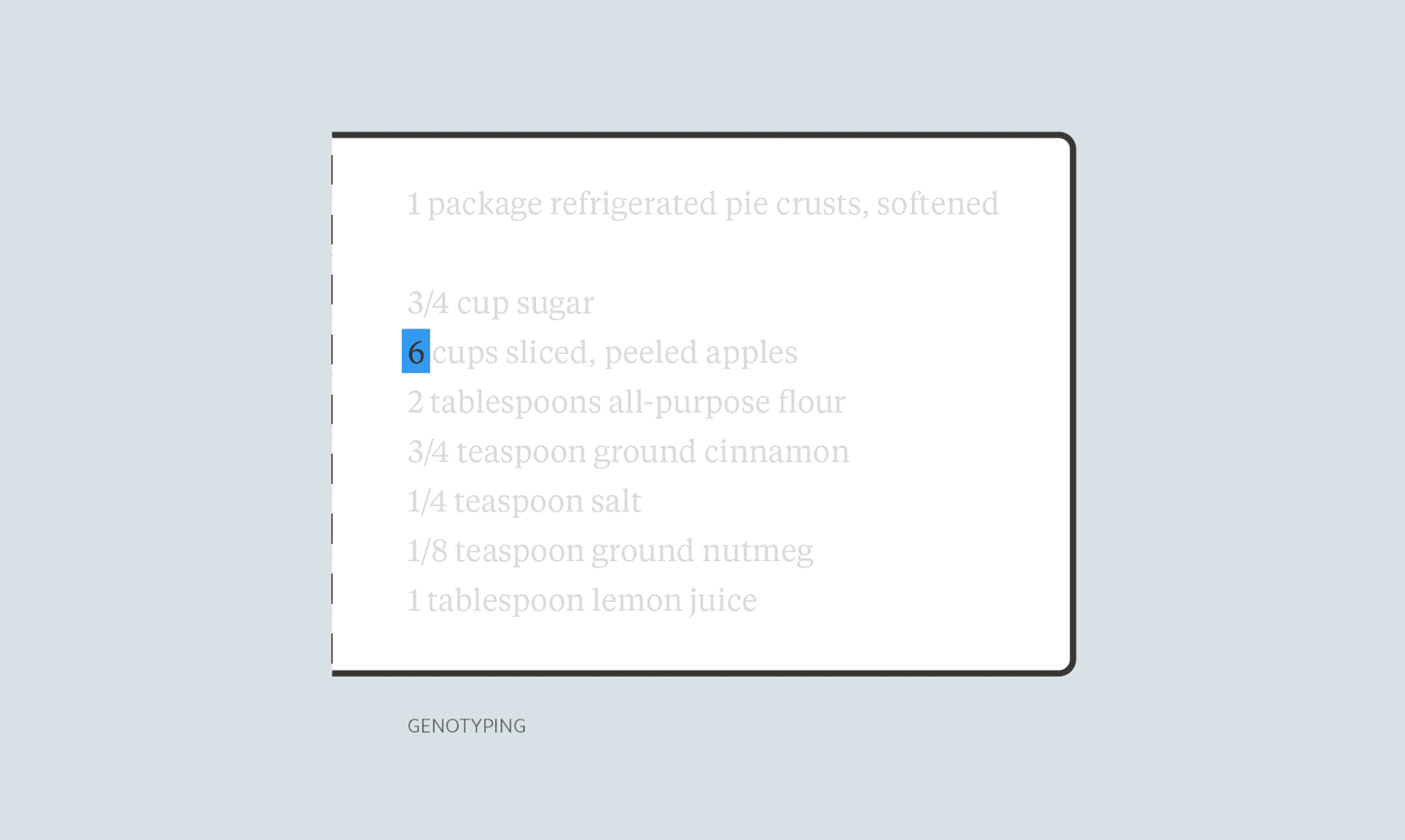
Genotyping would be like choosing a single letter from a single, specific, and predetermined page in a book.
Heterozygous: When an individual inherits a different variant (a single difference in the DNA between two people) from each parent, they are said to be heterozygous. Let’s think about it in terms of eye color. If you have one blue eyes variant and one brown eyes variant, you are heterozygous. Hetero means different.
Haploid: Haploid refers to a single complete set of chromosomes. Humans have two copies of 23 different chromosomes which gives us a total of 46. When we pass DNA on to the next generation, we use specialized cells (like a sperm cell or an egg cell) that carry only one copy of each chromosome—giving them one complete set of 23 chromosomes. These cells are considered haploid. Haploid cells have half the number of chromosomes as diploid cells.
Homozygous: When an individual inherits the same variant (a single difference in the DNA between two people) at the same position from both parents, they are said to be homozygous. Let’s think about it in terms of eye color. If you have two blue eyes variants, you are homozygous. Homo means same.
Human reference genome: A database of the human genome that the scientific community has identified as being a representative example and a standard against which other data can be compared. The human reference genome is used to identify where someone’s DNA sequence differs from that standard.
Imputation: Imputation is how we determine the bases (Adenine, Cytosine, Guanine, Thymine) at locations that we didn’t look at specifically. It relies on statistics to predict what base is there by knowing the bases that are nearby. If Helix didn’t sequence a specific base, we still might be able to predict what it is.
Inheritance: The passing down of genetic material from parents to their biological children. Traits that have been inherited have a genetic component. Something like enjoying to play basketball is not inherited, but being tall and fast can be inherited from your parents. Though you still might not like basketball, you have traits that predispose you toward being good at it.
Intron: Part of a gene that does not code for protein. Together, the exons and introns make up a gene. Introns are found in between exons like spaces between words.
Mendelian Traits: These traits are usually caused by a single gene and are usually entirely based on genetics; nothing in the environment can change them. Blood type is a good example. Your blood type is directly related to the blood type of your parents. The different blood types are A, B, AB, or O. If you inherit an ‘A’ blood type gene from one parent and a ‘B’ blood type gene from the other, you will have and ‘AB’ blood type.
Pedigree: A family tree that shows how one trait is passed down through a family.
Pharmacogenomics: The study of how variants (a single difference in the DNA between two people) affect the metabolism of certain medicine. Pharmacogenomics can predict how you respond to anesthesia or aspirin, whether you might experience side effects, and it can also determine how effective some drugs may be in treating you. Also known as PGx, pharmacogenomics can help a physician prescribe the right dose of certain medications.
Protein: The result of a gene’s instructions. Proteins affect traits while the gene is just the set of instructions to make the protein. For example, the eye color gene codes for a protein, and that protein is what is responsible for the color of the eye. The gene has the instructions for ‘blue’, but it’s the protein that actually makes the color.
Recessive: A type of variant (a single difference in the DNA between two people). And variants affect traits. You need two recessive variants to see the effect on a trait. For example, blue eyes variants are recessive. You need to get a blue eyes variant from your mom AND your dad to have blue eyes. If you only have one blue eyes variant, you don’t have blue eyes.
Risk: Probability that an individual will have a particular trait. Higher risk can be because you inherited variants from your parents, or it can be due to environment factors (like toxins, UV light, and the foods you eat). For example, you could be at risk for heart disease because you eat too much fast food and don’t get enough exercise. Or, you could be at risk for heart disease because you inherited heart disease variants from your parents. Many times, you might be at higher risk because of both genetic and environmental risks.
Sequencing: The process of reading bases (Adenine, Cytosine, Guanine, and Thymine) in DNA. You can sequence the entire genome (whole genome sequencing) or just sequence a few bases. The important thing is that you are reading bases that are next to each other, like reading the letters in a word. If we compare sequencing to genotyping (where genotyping is like reading choosing a single letter from a single, specific, and predetermined page in a book), sequencing is like reading whole sentences. In sequencing DNA, we get more information and more context.
At Helix, we use Next-Generation Sequencing (NGS), a technological improvement in the ability to read DNA. This technology is based on reading millions of pieces of DNA at the same time which reduces the total time and the cost of sequencing your DNA. Like being able to read every page of a book at once instead of one at a time.
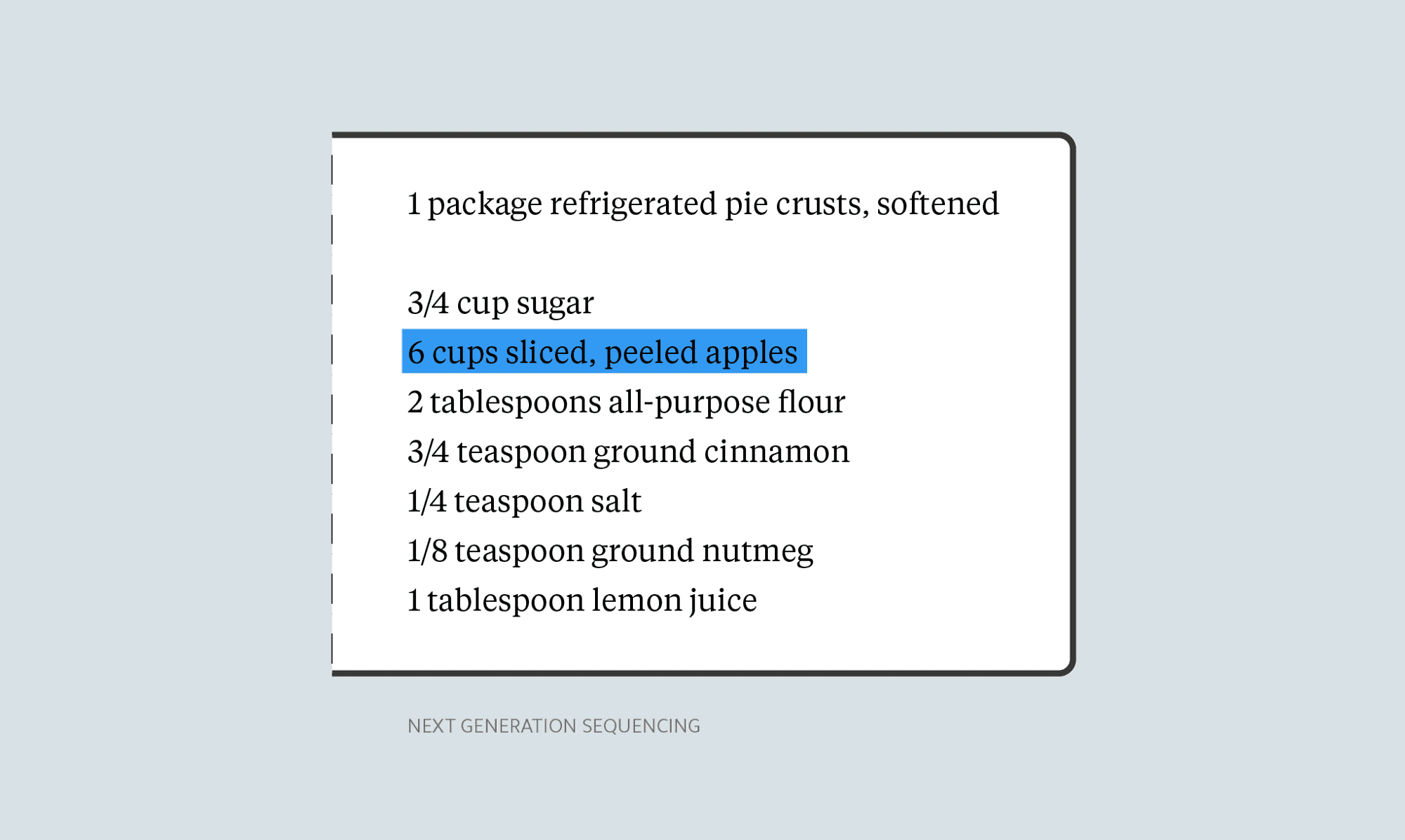
Next Generation Sequencing (NGS) would be like being able to read every page of a book at once. NGS also allows us to go back and reference any part of the page!
T (Thymine): One of the four DNA bases. Bases are the most basic unit of DNA. They are Adenine, Cytosine, Guanine, and Thymine. Without them we’re nothing. Like literally nothing.
Trait: The visible and non-visible representation of genetics. Visible characteristics (such as blue eyes or height) and non-visible characteristics like diseases (such as heart disease or Parkinson’s) are examples of traits. Sometimes, your environment influences traits. If you smoke, you are more likely to get lung cancer. In other cases, the environment doesn’t have any affect on your traits. For example, despite what you may have been told, eating crusty bread won’t turn your straight hair curly. But eating crusty bread is still delicious. Also known as a phenotype.
Variant: A single difference in the DNA between two people. These differences are normal and an important part of what makes every person unique. Variants don’t have to be bad (there is a blue eye variant and a brown eye variant) but they can cause disease (like a variant in the gene BRCA1 that increases the risk of breast cancer). Also known as: single nucleotide polymorphism (SNP), locus, marker, polymorphism, allele.
Whole Genome Sequencing (WGS): The process of reading every single base in the DNA of an individual. WGS includes the 2% of the genome that codes for protein + the 98% of the genome that doesn’t.
X-linked recessive: This means that the variant is found in a gene that’s located on the X chromosome and that it is recessive. “Recessive,” in this case, means that for someone to show or express the trait, they would have to inherit the variant on all copies of their X chromosome. Most of the time, people who are biologically male inherit only one copy of the X chromosome—meaning they would only need to inherit one copy of the X-linked recessive variant to show it’s associated trait. On the other hand, most of the time, people who are biologically female inherit two copies of the X chromosome and would thus need to inherit two copies of the X-linked recessive variant (one on each copy) to show the trait. Because of this, it is far more common for biologically male people to show X-linked recessive traits.
